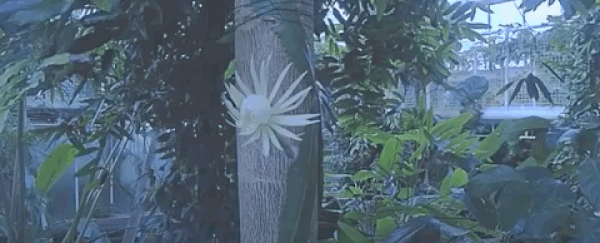The Amazon moonflower (Selenicereus wittii) has one of the most elusive blooms in the plant kingdom. Each year, for just one night, this rare and unusual cactus opens its sepals to the night sky, releasing a gorgeous white flower and a sweet, jasmine-like fragrance into the swampy rainforest air.
By morning, it's gone.
Around the world, only about 13 of these strange plants have been successfully cultivated by horticulturists, and in the United Kingdom, after five years of careful nurturing, experts at the Cambridge University Botanic Garden (CUBG) have caught the ephemeral flowering event on camera.
"It's very rare to have this plant in our collection and we believe this is the first time the Moonflower has flowered in the UK," says horticulturalist and glasshouse supervisor Alex Summers from CUBG.
A cutting of the cactus was originally acquired from the Bonn Botanic Garden in Germany in 2015 and has since grown, spiraled around a Water Chestnut tree in the glasshouse. Because the plant is an epiphyte - a plant that grows on another plant - it needs something to anchor to, and given seasonal floods in its native habitat, the cactus usually grows many meters above the ground, dropping its seeds to be carried away on the water.
Last year, in late November, Summers happened to look up and see a flower bud growing 3.6 meters (12 feet) off the ground. In the wild, the Amazon moonflower usually blooms in May, but under a glass roof in Europe, it's not usual for the cactus to begin blooming between November and February.
For months now, Summer and his colleagues have been keeping an eye on the bud, waiting for it to part.
On February 9, the team thought they'd reached that moment, so they began live streaming. The bud was the same length as its parent cactus in Germany when it had bloomed, and yet still, nothing happened.
At last, on February 20, their patience paid off, although not when the researchers were expecting it to. That morning, the sepals began to spread, and by 3 pm, the bud began to open, releasing a throng of long, white and pointy petals. By 5 pm the flower was fully open to the joy of hundreds of thousands of viewers around the world.
Experts at the glasshouse suspect the lighting from their cameras may have thrown off the plant's usual nighttime bloom, triggering the process earlier in the day than what happens in the wild.
Yet 12 hours later, right on cue, the flower began to fade, switching its scent to something a little more unpleasant, what Summer describes as the smell of a public toilet.
"We are so excited that this rare cactus has flowered now – ever since I realized that it was going to flower soon, we've all been in suspense!" said Summer in a statement.
"Everyone here at the Garden has been fascinated and I feel so lucky to have been here to experience it."
 The moonflower in full bloom. (CUBotanicGarden)
The moonflower in full bloom. (CUBotanicGarden)
The event is an opportunity for botanists to better understand this mysterious plant, which we still know so little about.
As horticulturalist and CUBG director Beverly Glover explains in a Q&A, the plant probably blooms so infrequently due to the balance of costs versus benefits. In the wild, the Amazon moonflower is vulnerable to predation and it relies heavily on camouflage to avoid being eaten.
That said, it also needs to attract night-flying moths to be properly pollinated. Hence, its moontime bloom and sweet smelling scent. As the flower begins to die, usually about two hours after fully blooming, it releases a foul odor, likely as a deterrent to herbivores.
Pollination of the moonflower has never been observed in the wild, so Glover and her colleagues are especially interested in discovering what traits make this plant so appealing to certain species of hawkmoths.
"Relatively little is known about the moonflower, so having it here in cultivation enables us to deepen our understanding about it," she explains.
"I took a sample of a couple of tepals which we will look at under the microscope to analyze the cell shape. They're currently being stored in the fridge before they die fully and we'll prepare casts from them to enable us to study them."
The plant should continue to survive, and the researchers hope it will continue to flower annually from now on. Because the plant has male and female reproductive structure, Summer has attempted to self-pollinate it, although Glover suspects this might fail, as no cactus family is particularly good at reproducing by itself.
We shall soon find out…
